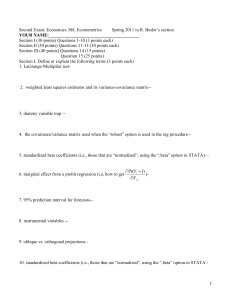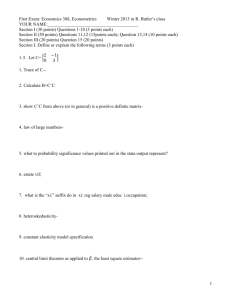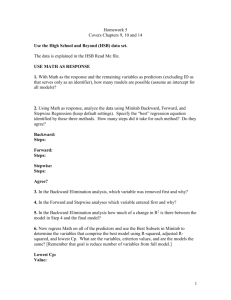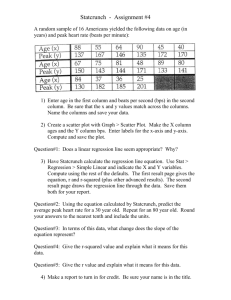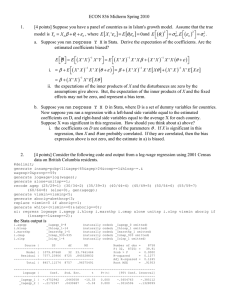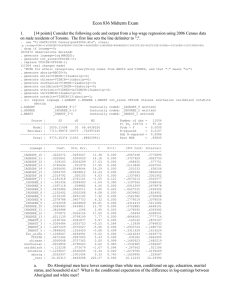Final - BYU Department of Economics
advertisement
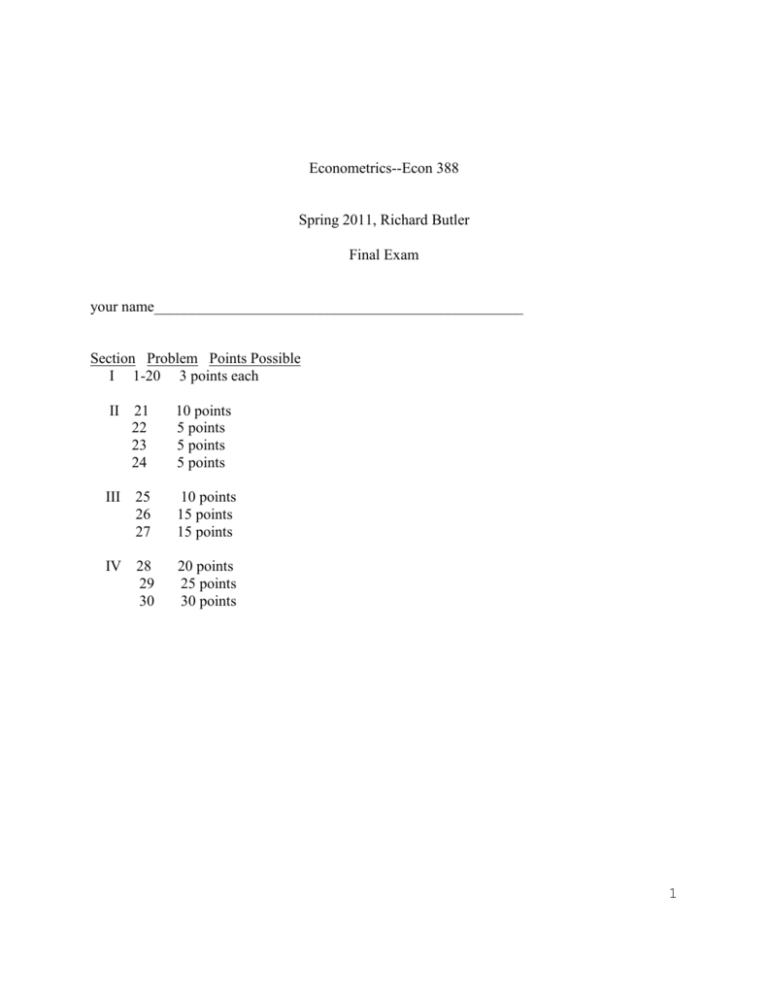
Econometrics--Econ 388
Spring 2011, Richard Butler
Final Exam
your name_________________________________________________
Section Problem Points Possible
I 1-20 3 points each
II 21
22
23
24
10 points
5 points
5 points
5 points
III 25
26
27
10 points
15 points
15 points
IV 28
29
30
20 points
25 points
30 points
1
I. Define or Explain the following terms:
1-6 STATA terms after a regression command
1. estat vif
2. predict harriet, residuals
3. list harriet
4. test (educ + exper=2)
5. hettest, rhs
6. mfx compute (after a “logit” regression command)
7-10 Commands with STATA “regressions”
7. xtreg wage educ exper occ1 occ2 occ3, FE(idnum)
8. regress a_grade gpa tuce_scr psi [w=WT]
9. regress ann_sale age in 1/1000
10. xi: regress ann_sale age i.training
2
11. regressand-
12. degrees of freedom (for a regression model)—
13. fitted value (for a regression model)—
14. explained sum of squares (SSE)—
15. p-value—
16. asymptotic bias—
17. smearing estimate—
18. dynamically complete (time series) regression model—
19. heteroskedasticity-robust F statistic--
20. first difference for a unit root process-3
II. Some Concepts
21. Corrections for
a) Heteroskedasticity, or
b) First Order Autoregressive Correlation, or
can be viewed as regressing TY on TX for the following linear model: Y X
In each of these two cases, indicate what the T matrix is that is pre-multiplied through the model
to make the respective correction (make clear whatever additional variables or parameters you
introduce represent).
4
22. U True, False or Uncertain, “Height is an important omitted variable in my regression, but
it is missing from the sample information (though it was originally available, but has since been
lost). Fortunately, I know that all the individuals in the sample were arranged in ascending order
by height (so that the individual with the smallest sample ID is the shortest, and the individual
with the largest sample ID is the tallest) AND that height is uniformly distributed. Therefore, if I
difference adjacent individuals in the sample and then run a regression (so that is regressed on
), I will get better estimates than if I just do the regression of on , in particular, I avoid a
heteroskedasticity problem due to omitted variables.”
5
The next question is True, False, or Uncertain (Sometimes True). You are graded solely on the
basis of your explanation in your answer.
23. “Instrumental variable estimators are commonly used in three cases: measurement error in
the dependent variable, measurement error in an independent variable, and for omitted variables
(even if the omitted variable is orthogonal to the included right hand side variables).”
24. In the first stage of two-stage least squares estimators, we project the right hand side
variables onto all exogenous variables collected in the “V” matrix, as given by
Xˆ V (V 'V ) 1V ' X where V has the appropriate dimensions. Then we use 𝑋̂ as an instrumental
variable. Show that Xˆ ' X Xˆ ' Xˆ .
6
III. Some Applications
25. Suppose that the population model is yi 1 xi i where i is distributed as a normal
random variable with a mean of zero and a variance of 2 . Note that there is only a slope
coefficient but no intercept coefficient. Also assume that the population errors are uncorrelated
(independent).
a. Use the orthogonality condition (that the length of the error vector is minimized) to get the
“normal” equation, and then solve that normal equation for the least squares estimator for 𝛽1 ,
which we denote by 𝛽̂1.
b. Show that 𝛽̂1 is unbiased.
c. Show that 𝛽̂1 is the BEST (meaning minimum variance) LINEAR UNBIASED ESTIMATOR
among all linear (in Y), unbiased estimators. (HINT: consider estimator 𝛽̃ = {(𝑋 ′ 𝑋)−1 𝑋 ′ +
𝐶}𝑌, an estimator linear in Y (nx1), where X is nx1, C is arbitrary matrix with size nx1).
7
26. Given the usual assumptions about the n by k matrix of instrumental variables, Z, prove that
the instrumental variable estimator is consistent:
Z'X
i.e., prove that for ˆIV (Z ' X )1 Z 'Y that plim ˆIV . (You may assume that
is a
n
positive definite matrix with finite elements for any value of n, the sample size).
8
27. The following regression (taken from your text) indicates what about the effect of education
and IQ on wages?
# delimit ; infile educ wage IQ using ‘d:\wage2.raw’;
/*
educ
years of education
wage
monthly earnings
IQ
IQ score
*/
. reg wage educ IQ;
Source |
SS
df
MS
-------------+-----------------------------Model | 20441576.8
2 10220788.4
Residual |
132274591
932 141925.527
-------------+-----------------------------Total |
152716168
934 163507.675
Number of obs
F( 2,
932)
Prob > F
R-squared
Adj R-squared
Root MSE
=
=
=
=
=
=
935
72.02
0.0000
0.1339
0.1320
376.73
-----------------------------------------------------------------------------wage |
Coef.
Std. Err.
t
P>|t|
[95% Conf. Interval]
-------------+---------------------------------------------------------------educ |
42.05762
6.549836
6.42
0.000
29.20348
54.91175
IQ |
5.137958
.9558274
5.38
0.000
3.262134
7.013781
_cons | -128.8899
92.18232
-1.40
0.162
-309.7988
52.01908
------------------------------------------------------------------------------
What does the following indicate:
A. R-squared?
B. coefficient of educ?
C. coefficient of IQ?
D. Are the slope regressors significant? How do you know? What hypothesis is being tested in
STATA?
E. In this second regression, IQ score has been omitted. Using an Omitted Variable Bias
analysis, explain what (derive the results that indicate how you know) the more positive
coefficient in this second regression suggests about the correlation of IQ and education
attainment?
. reg wage educ;
Source |
SS
df
MS
-------------+-----------------------------Model | 16340644.5
1 16340644.5
Residual |
136375524
933 146168.836
-------------+-----------------------------Total |
152716168
934 163507.675
Number of obs
F( 1,
933)
Prob > F
R-squared
Adj R-squared
Root MSE
=
=
=
=
=
=
935
111.79
0.0000
0.1070
0.1060
382.32
-----------------------------------------------------------------------------wage |
Coef.
Std. Err.
t
P>|t|
[95% Conf. Interval]
-------------+---------------------------------------------------------------educ |
60.21428
5.694982
10.57
0.000
49.03783
71.39074
_cons |
146.9524
77.71496
1.89
0.059
-5.56393
299.4688
------------------------------------------------------------------------------
9
IV. Some Proofs
28. Prove that s2, the estimator of the variance of i (where i is the error term in the classical
regression model), is unbiased using matrix algebra.
10
29. STATA Output and interpretation: In FHSS college professors example (from lecture 1, and
several times since then), I regress wages on years of teaching experience, plus a new “dummy”
variable for the 11th observation, defined implicitly as follows(namely, -1 for the 11th
observation, zero for everyone else):
input obs salary experience dummy;
1 45000
2 0;
2 60600
7 0;
3 70000
10 0;
4 85000
18 0;
5 50800
6 0;
6 64000
8 0;
7 62500
8 0;
8 87000
15 0;
9 92000
25 0;
10 89500
22 0;
11 0
12 -1;
end;
reg salary experience dummy;
estat vif;
estat hottest, rhs;
Source |
SS
df
MS
-------------+-----------------------------Model | 6.8515e+09
2 3.4257e+09
Residual |
233299765
8 29162470.6
-------------+-----------------------------Total | 7.0848e+09
10
708477636
Number of obs
F( 2,
8)
Prob > F
R-squared
Adj R-squared
Root MSE
=
=
=
=
=
=
11
117.47
0.0000
0.9671
0.9588
5400.2
-----------------------------------------------------------------------------salary |
Coef.
Std. Err.
t
P>|t|
[95% Conf. Interval]
-------------+---------------------------------------------------------------experience |
2128.714
238.9154
8.91
0.000
1577.774
2679.654
dummy |
70427.13
5663.858
12.43
0.000
57366.25
83488.01
_cons |
44882.56
3357.591
13.37
0.000
37139.94
52625.18
-----------------------------------------------------------------------------Variable |
VIF
1/VIF
-------------+---------------------dummy |
1.00
0.999982
experience |
1.00
0.999982
Breusch-Pagan / Cook-Weisberg test
chi2(2)
=
0.79
Prob > chi2 =
0.6721
a) What does the “dummy” variable coefficient and its standard error in the regression indicate?
b) What does the VIF scores indicate?
c) What does last Chi-square test at the bottom of the output indicate?
11
30. For the following structural model of worker supply and demand of labor:
Demand: 𝑊𝑖 = 𝛽1 𝐻𝑖 + 𝛽0 + 𝛽2 𝑂𝐽𝑇𝑖 + 𝛽3 𝑃_𝑟𝑜𝑏𝑜𝑡𝑠 + 𝜀𝑖
Supply: 𝐻𝑖 = 𝛼1 𝑊𝑖 + 𝛼0 + 𝜇𝑖
Where W=wage rate, H=hours of work, OJT=on-the-job training, P_robots=price of robotic
replacement equipment
a. illustrate which structural coefficients can be determined from the reduced form coefficients,
where the reduced form is given as
𝑊𝑖 = 𝜋𝑜 + 𝜋1 𝑂𝐽𝑇𝑖 + 𝜋2 𝑃_𝑟𝑜𝑏𝑜𝑡𝑠𝑖 + 𝜀𝑖 ′
𝐻𝑖 = 𝛾𝑜 + 𝛾1 𝑂𝐽𝑇𝑖 + 𝛾2 𝑃_𝑟𝑜𝑏𝑜𝑡𝑠𝑖 + 𝜇𝑖 ′
b. For those structural equations (if any) which are identified, indicate the STATA commands to
estimate them by two-stage least squares:
12
